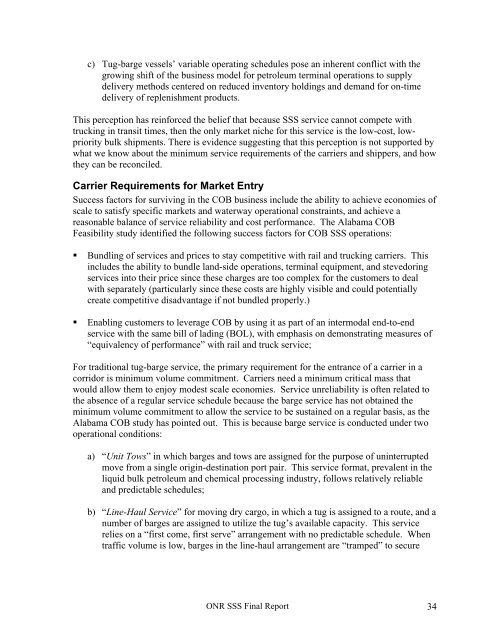Office of Naval Research - National Transportation Library
Office of Naval Research - National Transportation Library
Office of Naval Research - National Transportation Library
You also want an ePaper? Increase the reach of your titles
YUMPU automatically turns print PDFs into web optimized ePapers that Google loves.
c) Tug-barge vessels’ variable operating schedules pose an inherent conflict with thegrowing shift <strong>of</strong> the business model for petroleum terminal operations to supplydelivery methods centered on reduced inventory holdings and demand for on-timedelivery <strong>of</strong> replenishment products.This perception has reinforced the belief that because SSS service cannot compete withtrucking in transit times, then the only market niche for this service is the low-cost, lowprioritybulk shipments. There is evidence suggesting that this perception is not supported bywhat we know about the minimum service requirements <strong>of</strong> the carriers and shippers, and howthey can be reconciled.Carrier Requirements for Market EntrySuccess factors for surviving in the COB business include the ability to achieve economies <strong>of</strong>scale to satisfy specific markets and waterway operational constraints, and achieve areasonable balance <strong>of</strong> service reliability and cost performance. The Alabama COBFeasibility study identified the following success factors for COB SSS operations:• Bundling <strong>of</strong> services and prices to stay competitive with rail and trucking carriers. Thisincludes the ability to bundle land-side operations, terminal equipment, and stevedoringservices into their price since these charges are too complex for the customers to dealwith separately (particularly since these costs are highly visible and could potentiallycreate competitive disadvantage if not bundled properly.)• Enabling customers to leverage COB by using it as part <strong>of</strong> an intermodal end-to-endservice with the same bill <strong>of</strong> lading (BOL), with emphasis on demonstrating measures <strong>of</strong>“equivalency <strong>of</strong> performance” with rail and truck service;For traditional tug-barge service, the primary requirement for the entrance <strong>of</strong> a carrier in acorridor is minimum volume commitment. Carriers need a minimum critical mass thatwould allow them to enjoy modest scale economies. Service unreliability is <strong>of</strong>ten related tothe absence <strong>of</strong> a regular service schedule because the barge service has not obtained theminimum volume commitment to allow the service to be sustained on a regular basis, as theAlabama COB study has pointed out. This is because barge service is conducted under twooperational conditions:a) “Unit Tows” in which barges and tows are assigned for the purpose <strong>of</strong> uninterruptedmove from a single origin-destination port pair. This service format, prevalent in theliquid bulk petroleum and chemical processing industry, follows relatively reliableand predictable schedules;b) “Line-Haul Service” for moving dry cargo, in which a tug is assigned to a route, and anumber <strong>of</strong> barges are assigned to utilize the tug’s available capacity. This servicerelies on a “first come, first serve” arrangement with no predictable schedule. Whentraffic volume is low, barges in the line-haul arrangement are “tramped” to secureONR SSS Final Report 34
















